These soft and fluffy gluten-free burger buns are perfect for your summer backyard grilling party (or anytime you crave a good burger). Easy to make, these tender gf hamburger buns are studded with sesame seeds, and no kneading is required! Totally dairy-free too, but no one would care!
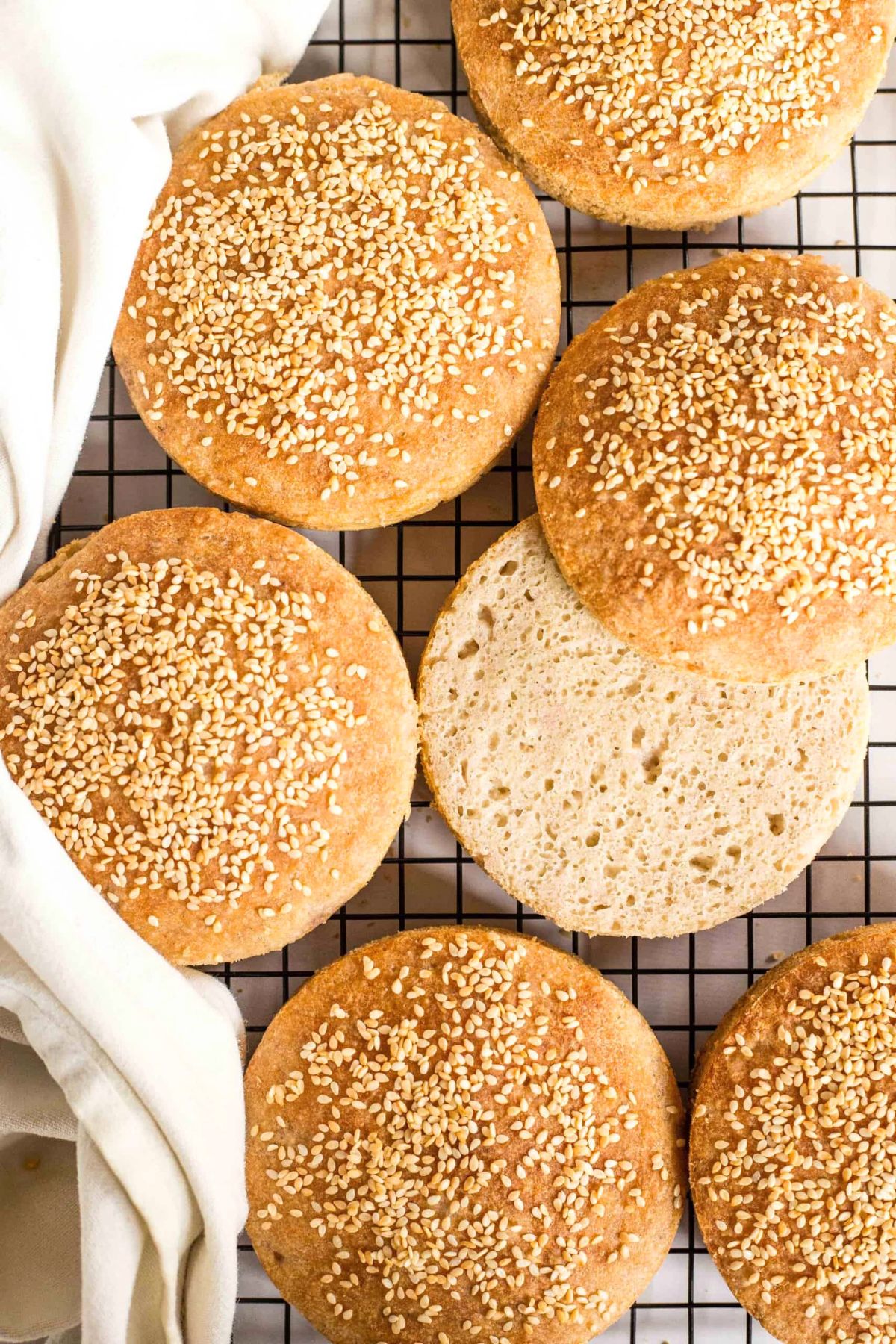
Want to save this recipe?
Enter your email & I’ll send it to your inbox. Plus, get great new recipes from me every week!
Jump to:
- Homemade Bread is the Best
- Make Your Own Homemade Hamburger Buns
- Why This Recipe Works:
- Ingredients You’ll Need:
- Recipe Notes/Substitutions:
- How to Make Gluten-Free Hamburger Buns (Step by Step):
- Dish by Dish Tips/Tricks:
- Recipe FAQs:
- Other Gluten-Free Yeast Breads You’ll Love:
- Gluten-Free Bread Recipes to Bake:
- Gluten-Free Hamburger Buns (Dairy-Free)
Homemade Bread is the Best
I have a penchant for homemade bread, and in my opinion, nothing beats pulling a fresh loaf from the still-warm oven, the heat and aroma enveloping you all at once.
In particular, I love baking yeast breads, because there’s just something enchanting about watching bread dough rise and double in size, as the yeast works its magic and creates those desired air pockets to give bread the soft, tender texture we all love.
Some favorite yeast breads include this gluten-free white bread, our insanely popular buckwheat bread, this tender brown rice bread, and this beautiful no-knead artisan bread.
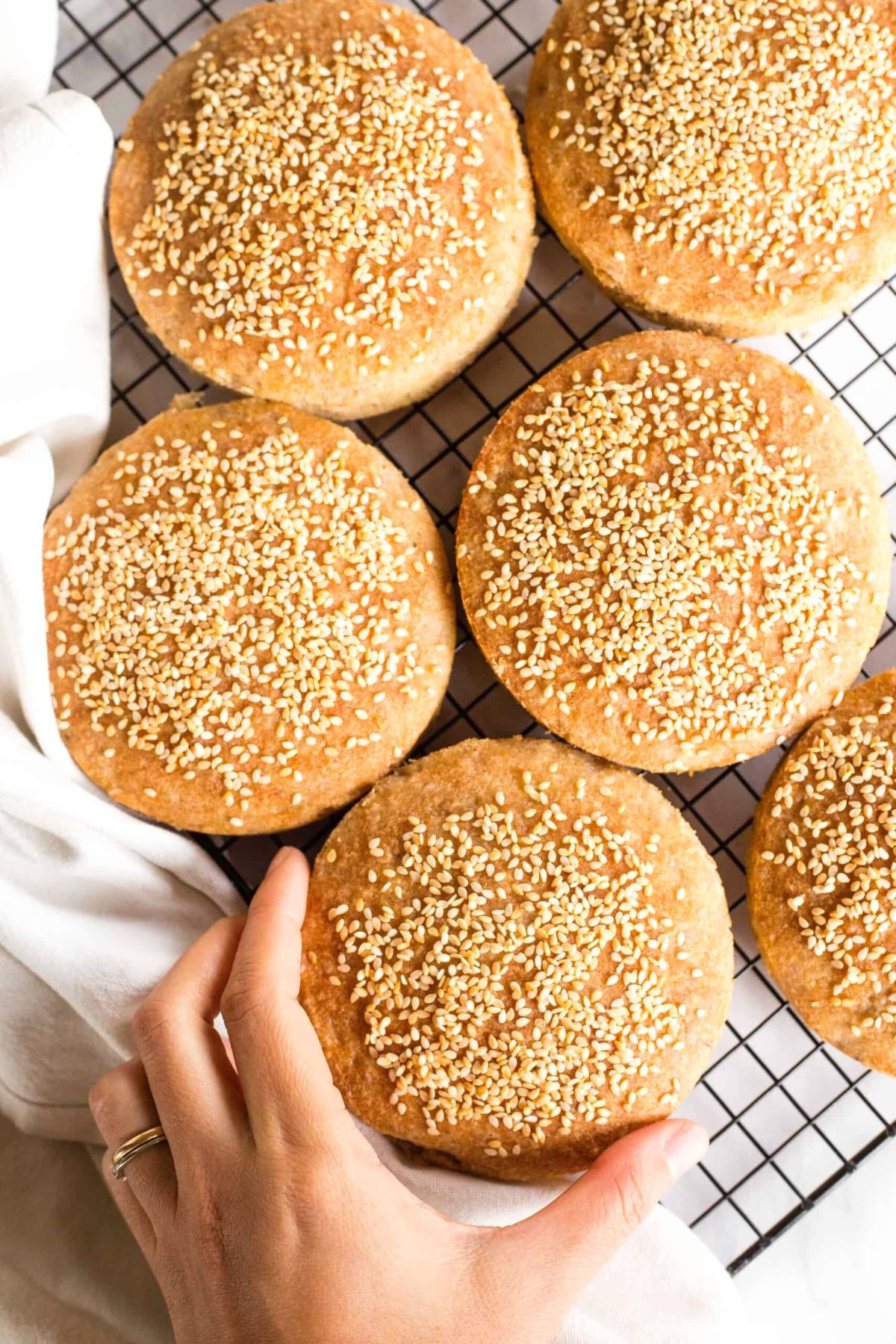
Make Your Own Homemade Hamburger Buns
For the longest time, I’ve had hamburger buns on my to-bake list, but only managed to get to testing and developing a recipe for it recently.
While I’ve made yeast-free low carb buns before, those were smaller in size and better for sliders as compared to regular-sized burgers.
This time, I wanted to make a gluten-free bun recipe for burgers. Using almost the same dough from my gluten-free bread recipe, I created these homemade gluten-free hamburger buns that turned out not only beautiful but also incredibly fluffy and delicious!
These gluten-free hamburger buns are perfect for sandwiching your favorite meat burgers or even veggie burgers. YUM!
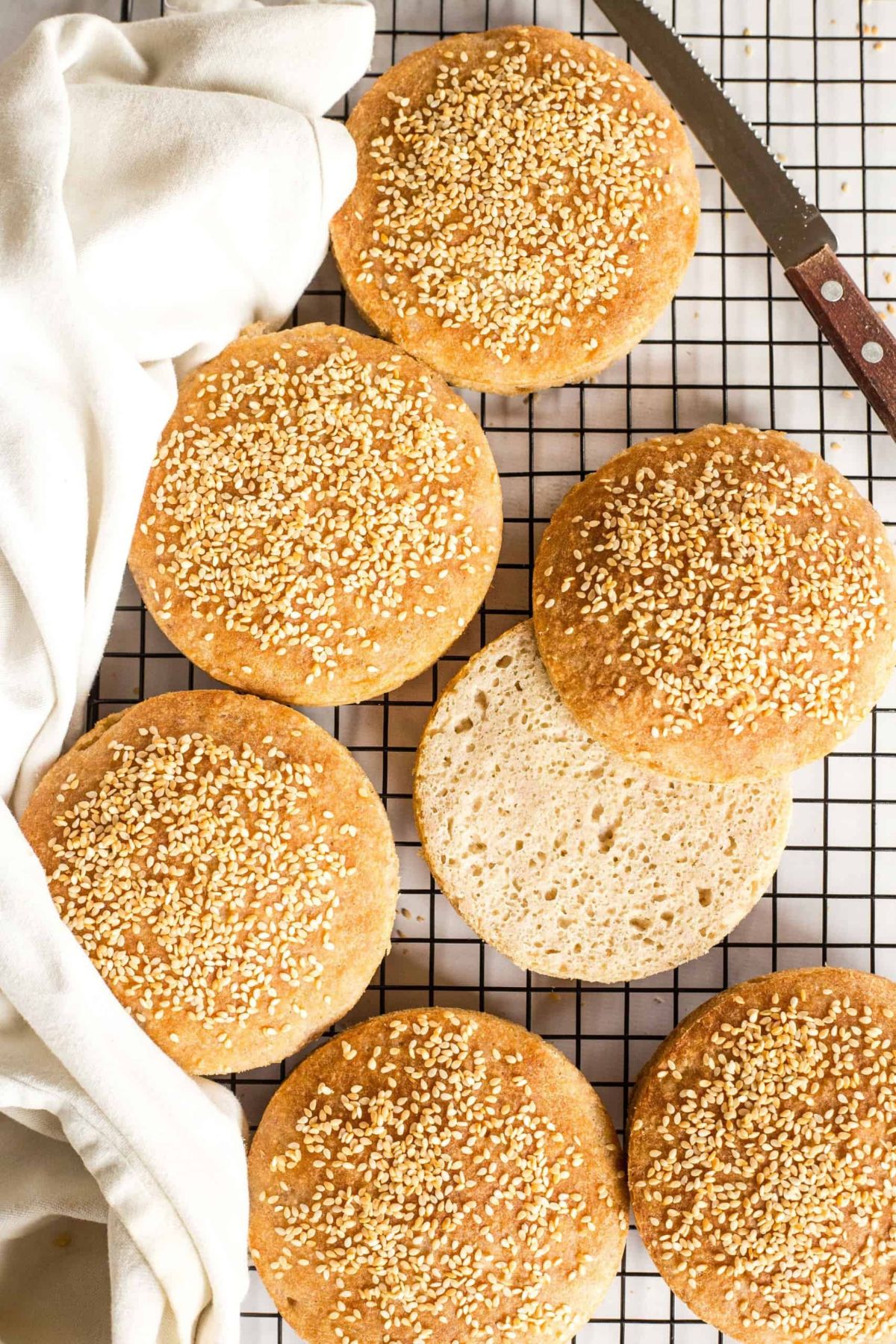
Why This Recipe Works:
- Simple Ingredients: You might already have most or all of the ingredients required to make these homemade hamburger buns, and if not, they are easily accessible at the grocery store (nothing fancy required!).
- Easy to Make: All you need to do is mix the dry ingredients with the wet ingredients and then divide the dough between round metal rings and let the dough rise before baking. Oh, and did I already mention that NO kneading is involved in this gluten-free bun recipe??
- Soft, Fluffy & Tender: Filled with air pockets thanks to the yeast, these golden buns have a fluffy texture and are the perfect size for holding your hamburger patties together. Say goodbye to dry and hard gluten-free buns for good!
- Totally Gluten-Free & Dairy-Free: Unlike traditional buns, this hamburger bun recipe is 100% gluten-free and dairy-free, which means that even those with Celiac disease or gluten and dairy intolerances can eat it, and the whole family can enjoy burgers during the summer grilling season. Say goodbye to the lettuce wrap and hello to a proper burger again!
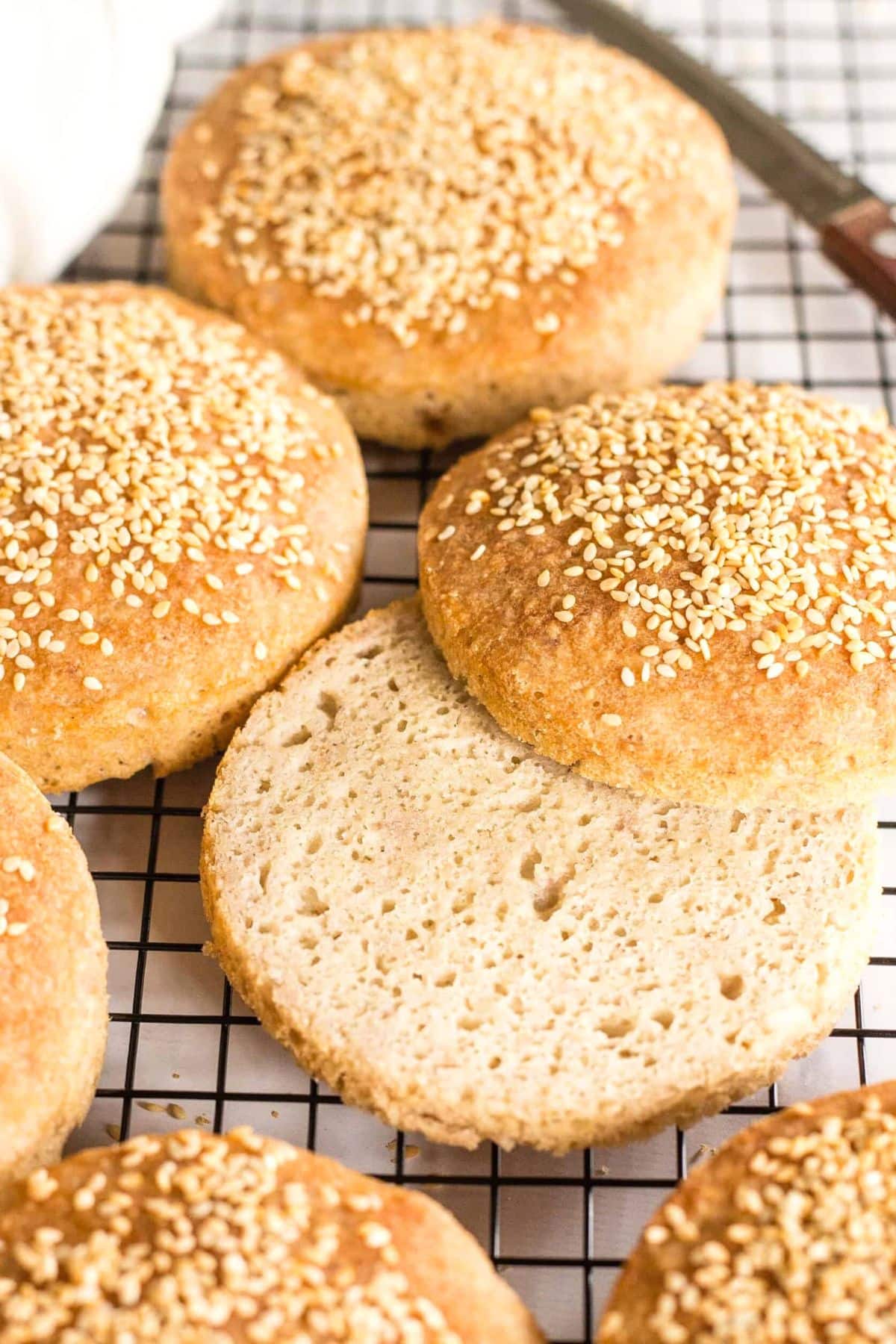
Ingredients You’ll Need:
Here’s a visual overview of the ingredients required for these homemade gluten-free burger buns.
(For exact measurements, please scroll down to the printable recipe card at the bottom of this post.)
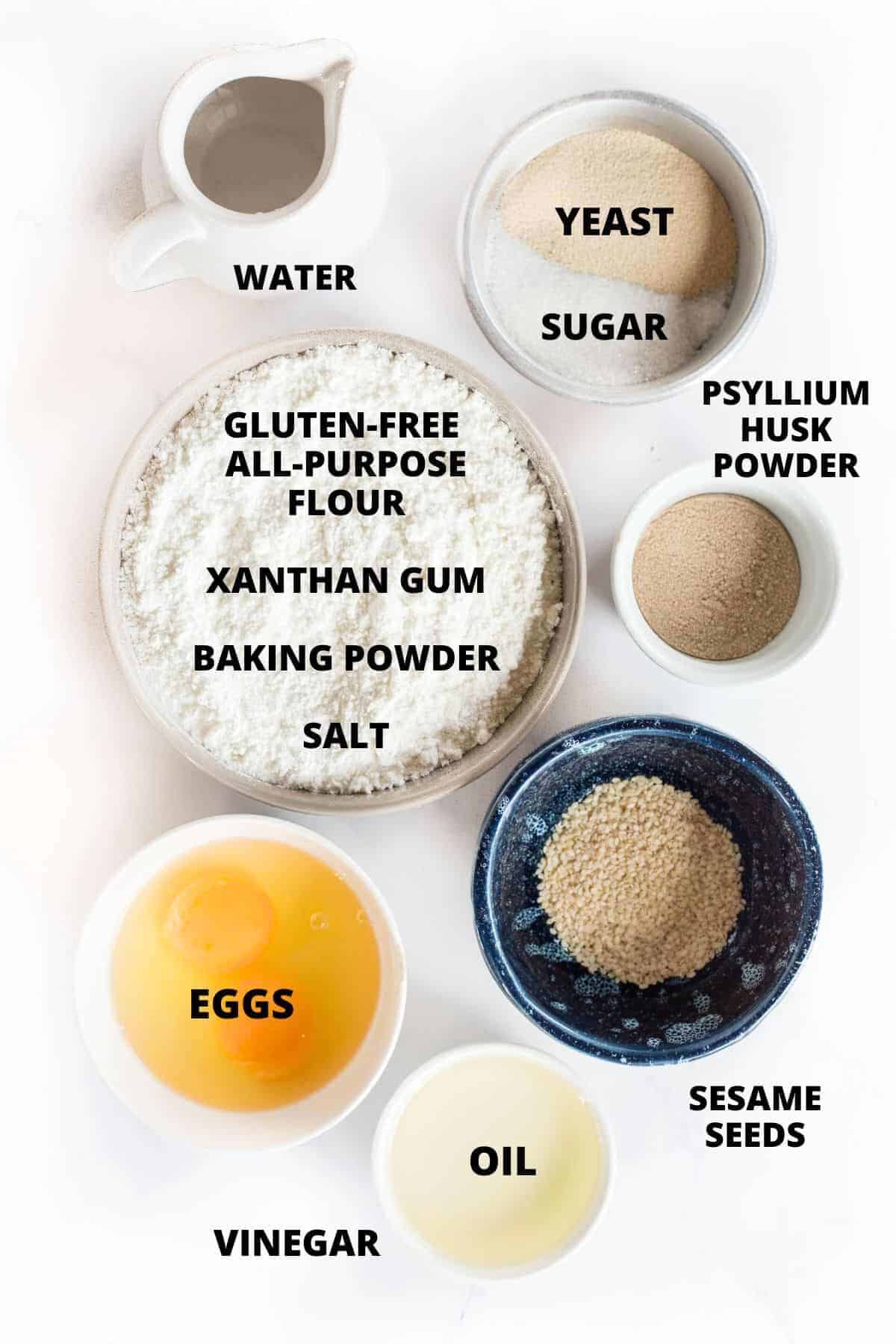
Recipe Notes/Substitutions:
- Gluten-Free Flour Blend: I highly recommend using a good-quality gluten-free all-purpose flour blend that is made up of lighter flours/starches (such as rice flour, tapioca starch, corn starch, or potato starch) to ensure a lighter final texture. I do NOT recommend flour blends that include heavier flours (such as garbanzo bean flour).
- Xanthan Gum: Xanthan gum is the replacement for gluten in gluten-free flours and helps the ingredients to bind together. If your gluten-free flour blend does not already include xanthan gum, make sure to include it.
- Instant Yeast: Yeast is the main leavening agent in this gluten-free burger bun recipe, so make sure you include it. I prefer using instant yeast because there’s no need for pre-activation (if you only have active dry yeast, make sure to activate the yeast beforehand by mixing it with warm water and sugar and letting it sit for a few minutes before mixing it with the other ingredients).
- Sugar: The sugar is “food” for the yeast to feed on in order to be activated and to produce the gases required to make the dough rise. I used white sugar, but you can also use cane sugar, light brown sugar or dark brown sugar if you prefer.
- Baking Powder: While this gluten-free burger bun recipe mainly uses instant yeast as a leavening agent, a little bit of baking powder gives the dough a little extra rise. If you are Celiac or gluten-intolerant, make sure to us a certified gluten-free baking powder.
- Psyllium Husk Powder: I find that psyllium husk powder really gives gluten-free dough elasticity and makes a big difference in how the final texture of the baked bread turns out. It is also a good source of fiber. If you only have whole psyllium husks available, you can grind the husks in a coffee grinder until you get a fine powder.
- Oil: I like using sunflower oil because I always have a bottle of sunflower oil on hand. However, you may also use other vegetable oils such as extra virgin olive oil, avocado oil, or melted coconut oil or canola oil. Alternatively, if you are not lactose-intolerant, feel free to use melted butter or ghee instead.
- Vinegar: Adding vinegar creates an acidic environment that reacts with the baking powder to help the dough rise more. You can either use white vinegar or apple cider vinegar.
- Warm Water: Make sure that the water is between 105 to 115F (neither too cold nor too hot), as you need a little warmth to activate the yeast, but if the water is too hot, it will cause the yeast to die. Alternatively, you may also use warm dairy-free milk (such as almond milk, cashew milk, or rice milk) or normal milk instead.
- Eggs: Eggs help the ingredients to bind better together. If you don’t want to use the yolks, then use 4 egg whites instead of 2 whole eggs. I have not tried this recipe without eggs so I don’t know how it will turn out, but if you are allergic to eggs, you may try using aquafaba or an egg-replacer. (If you do make this recipe egg-free, please let me know how it goes in the comments below, I’d love to hear!)
- Sesame Seeds: I like sprinkling white sesame seeds on top of the buns, but you may also use a mix of sesame seeds, or other seeds of your choice (such as poppy seeds). For extra flavor, you can also sprinkle the top of the dough with everything bagel seasoning. Alternatively, feel free to leave out the seeds directly if you prefer.
How to Make Gluten-Free Hamburger Buns (Step by Step):
1. Preheat, Line and Grease
Preheat the oven to 350F and line a large baking sheet with parchment paper or a silpat. Grease 6 round metal rings and place them spaced out evenly on the prepared baking sheet.
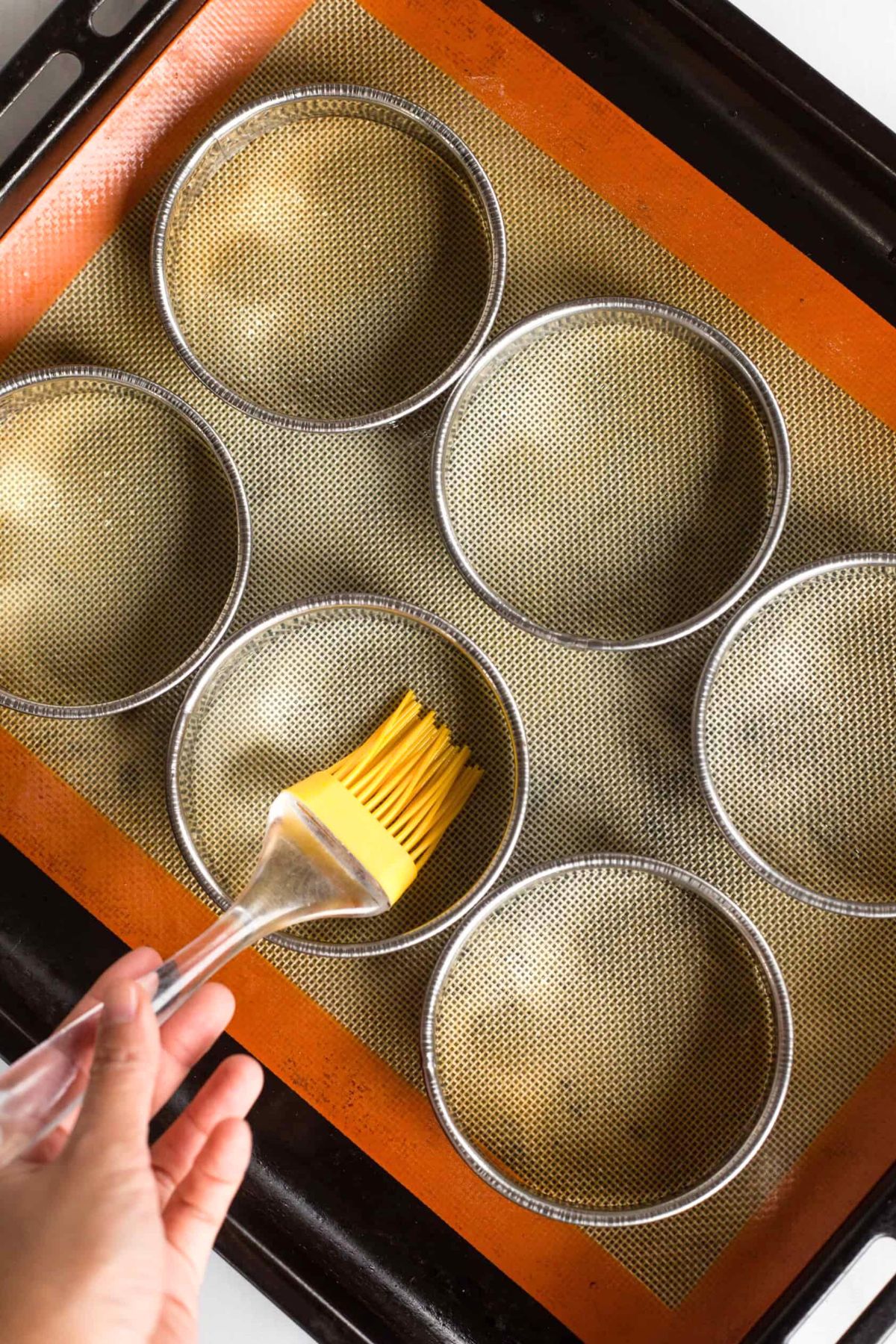
2. Whisk Dry Ingredients
In a large mixing bowl, whisk the gluten-free all-purpose flour, xanthan gum (if using), baking powder, salt, instant yeast, sugar and psyllium husk powder.
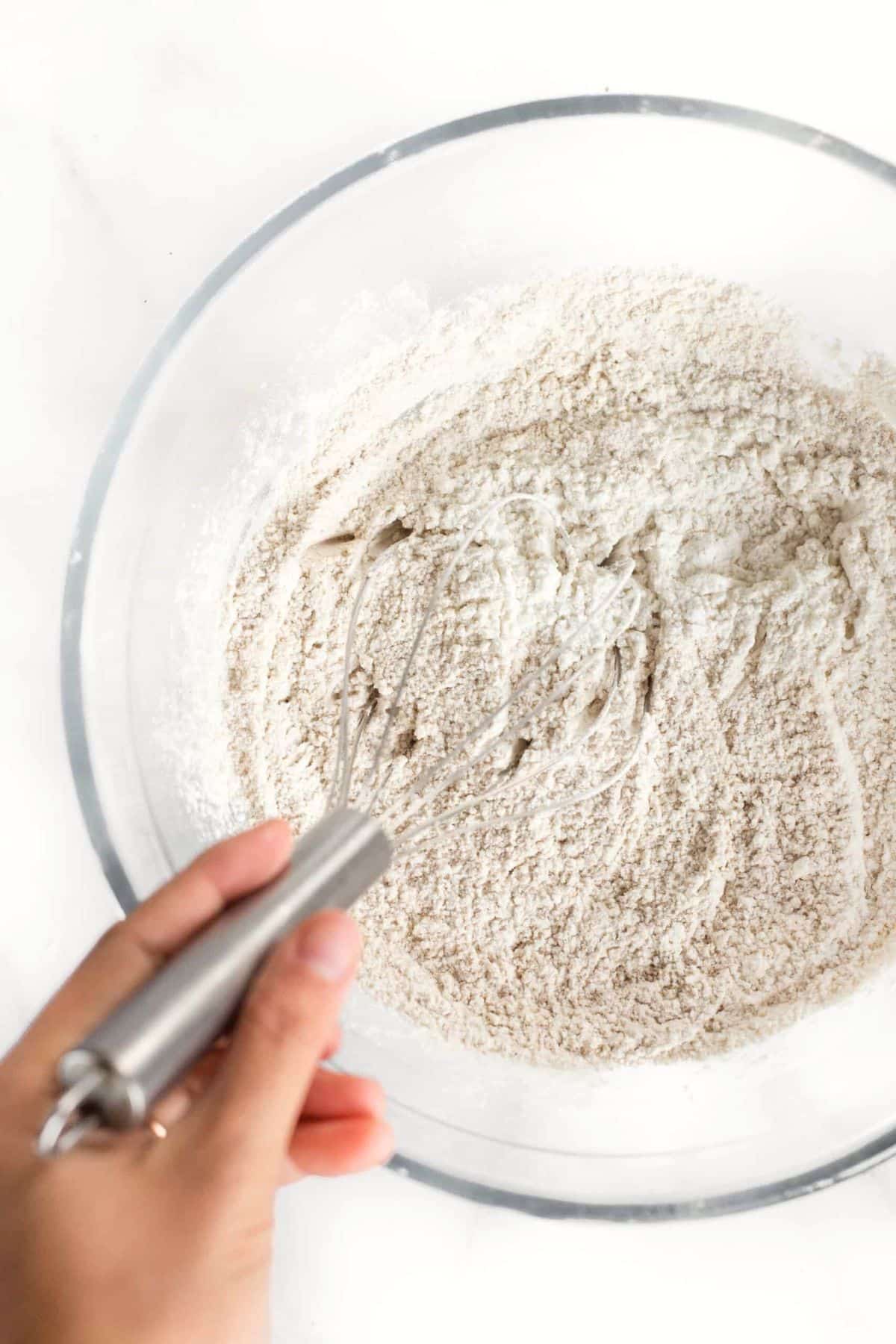
3. Add Wet Ingredients
Add the vegetable oil, vinegar, warm water and beaten eggs. Mix well until you get a dough that resembles cake batter (the dough will be shaggy and wet, but that’s the consistency you want).
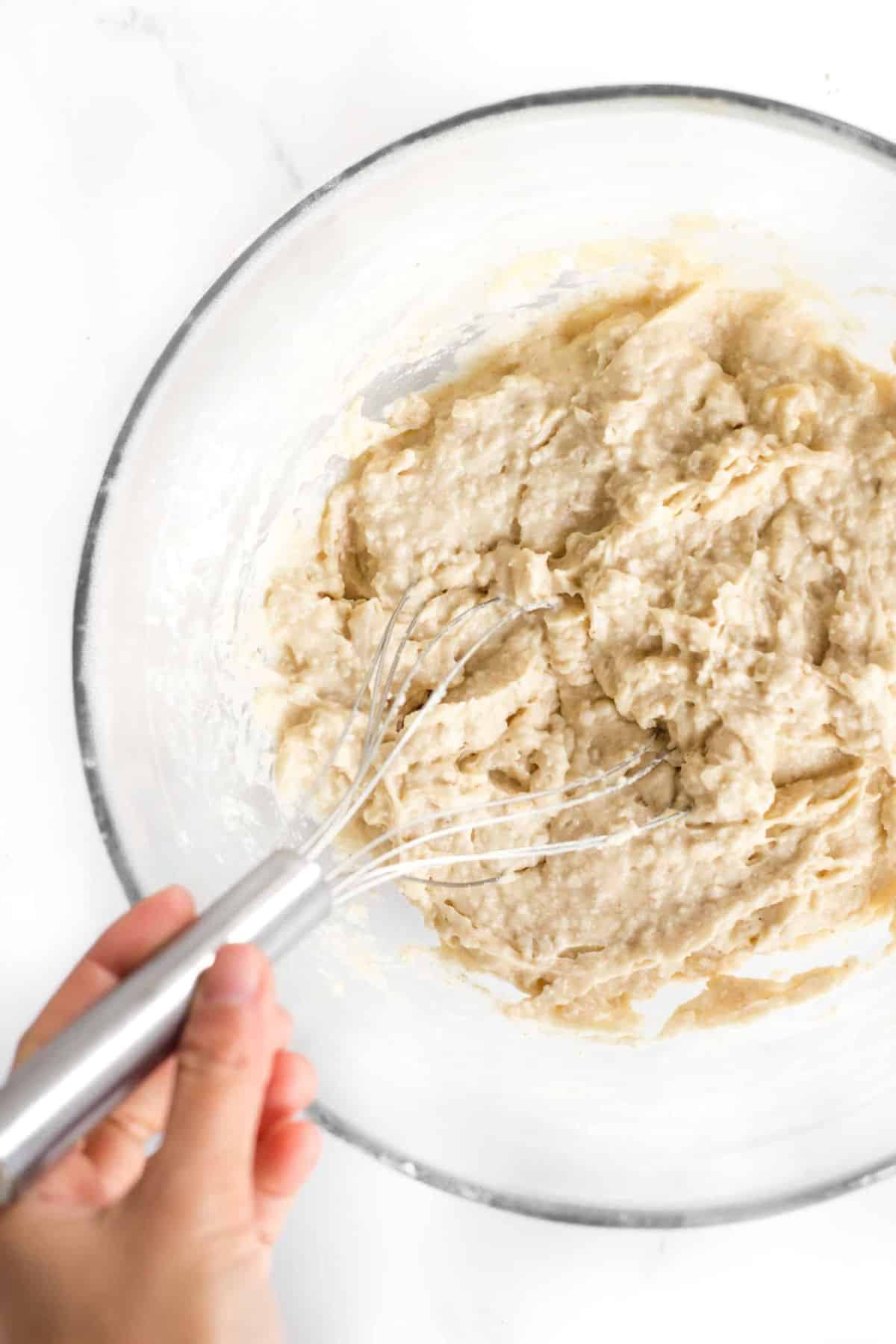
4. Divide Dough Between Rings
Divide the dough evenly between the metal rings and smooth out the tops of the dough with the back of a wet spoon.
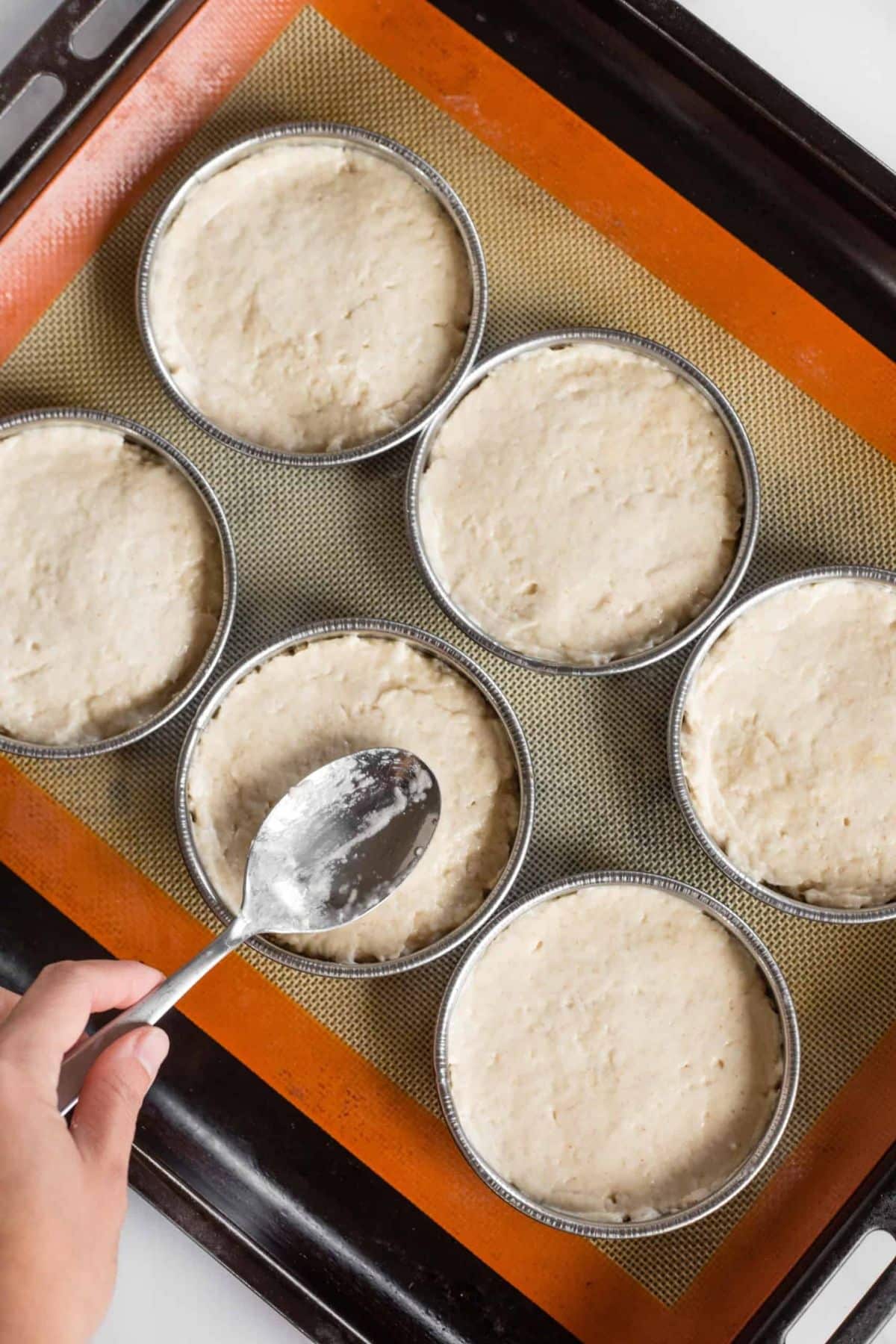
5. Let Rise Until Doubled
Allow the dough rise in a warm place (that’s free of wind drafts) until it has roughly doubled in size. (Depending on the temperature and humidity, it may take as little as 30 minutes in a warm and humid climate or up to 1 hour if you’re in winter).
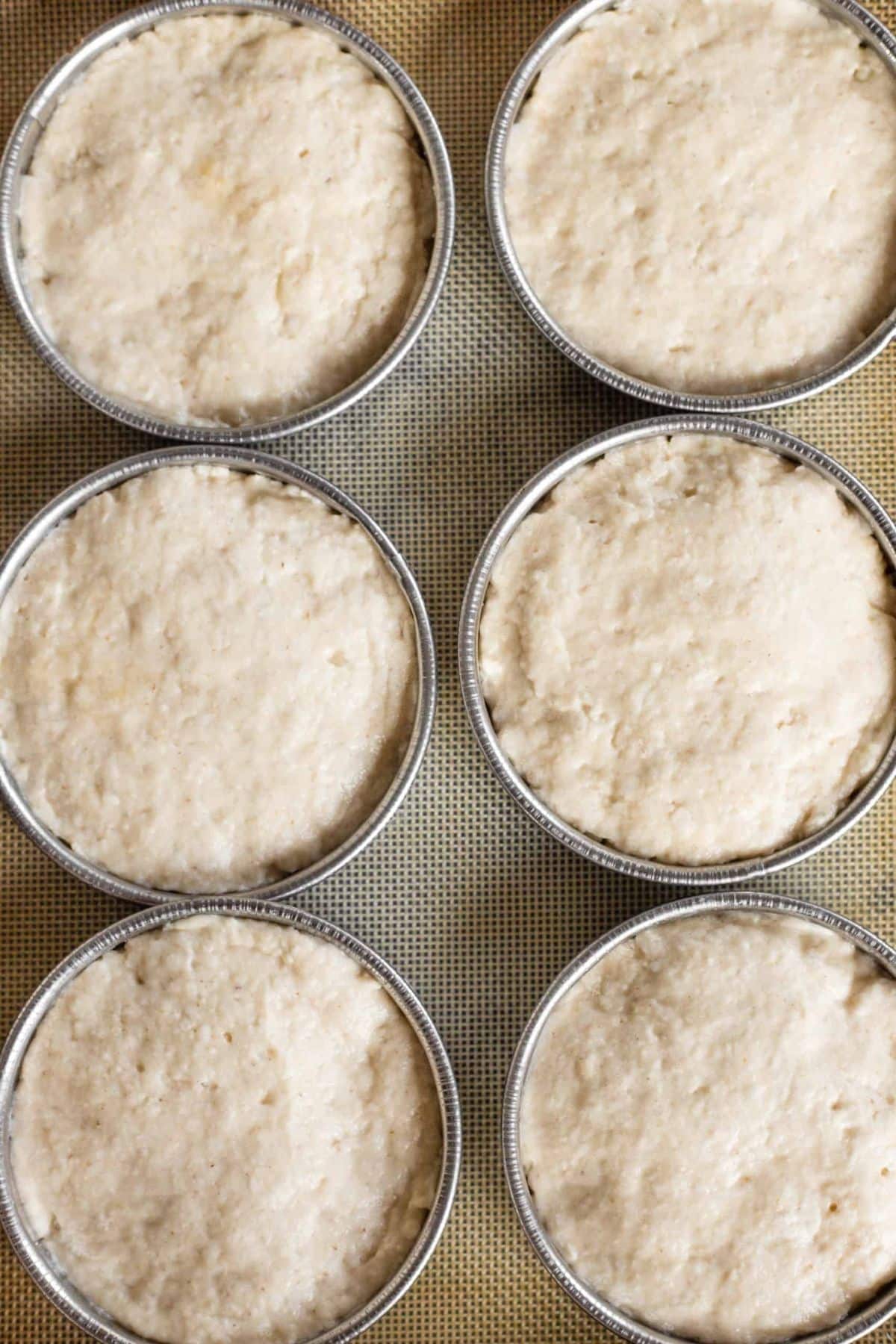
6. Brush the Tops with Oil
Use a silicon brush to brush the tops of the dough with oil.
(Tip: Alternatively, if you wish to, you can brush the tops of the dough with egg wash instead of oil.)
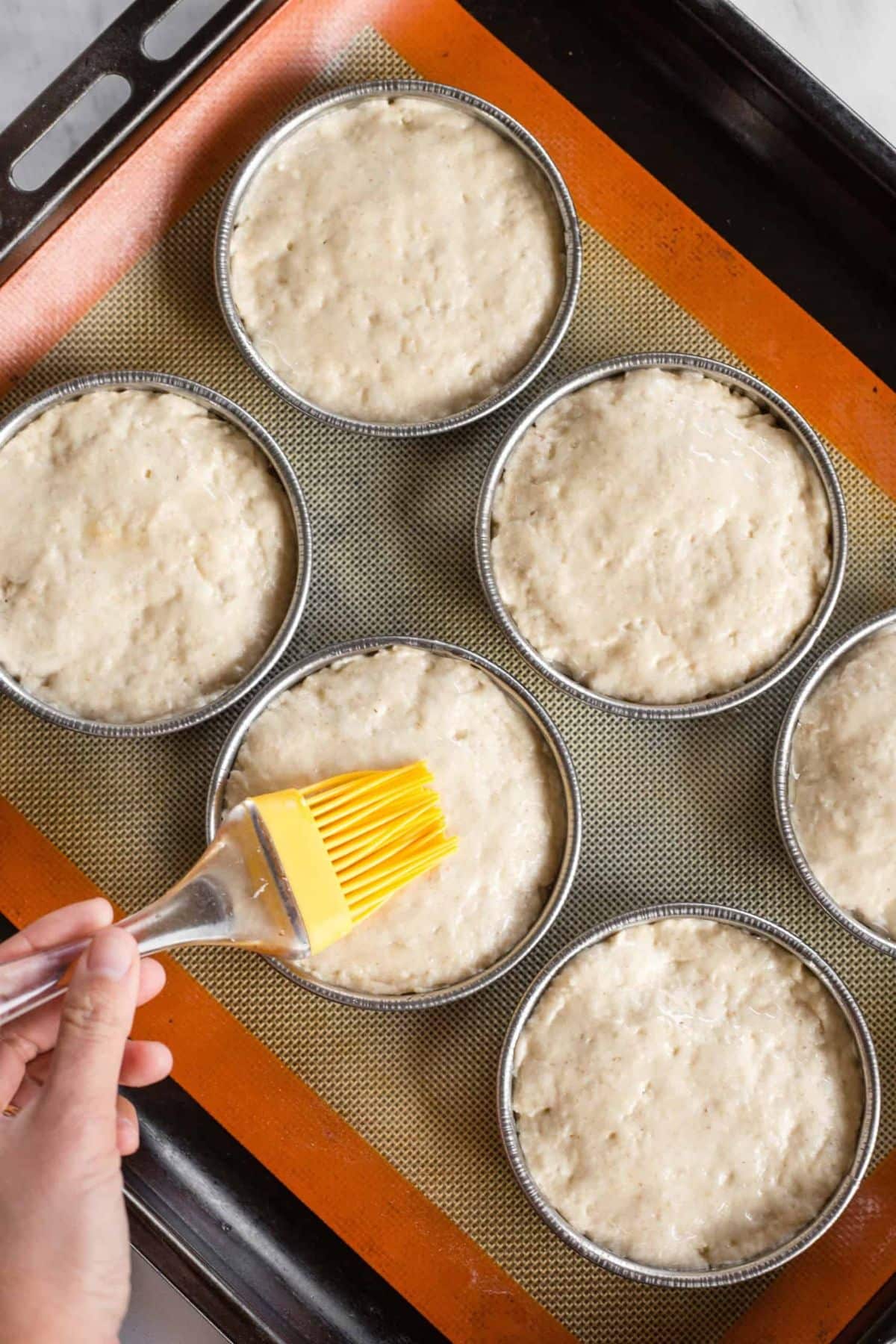
7. Sprinkle Seeds on Top
Sprinkle sesame seeds on top of the dough.
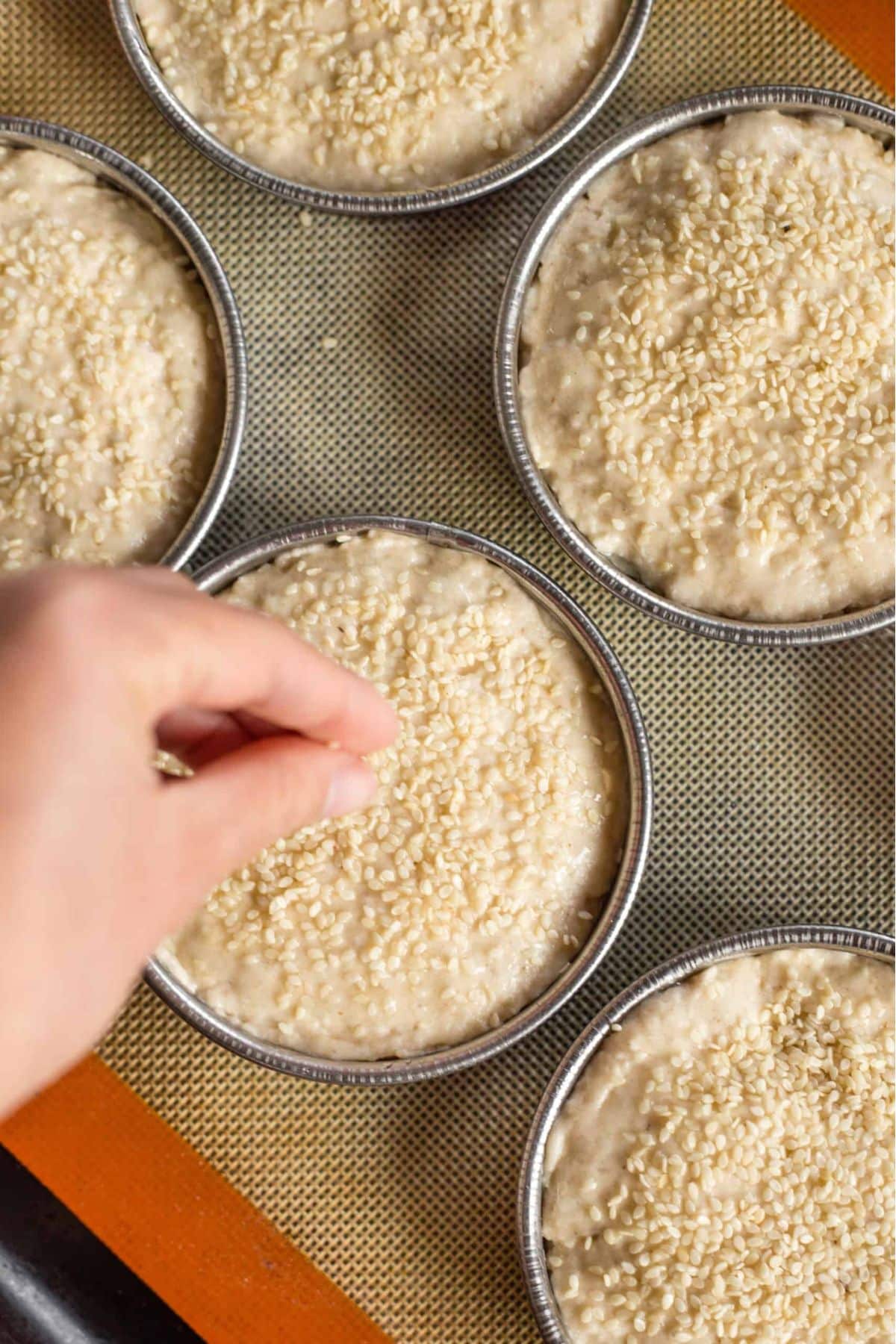
8. Bake Until Golden
Bake for 30 to 40 minutes until the gf hamburger buns are golden brown on top.
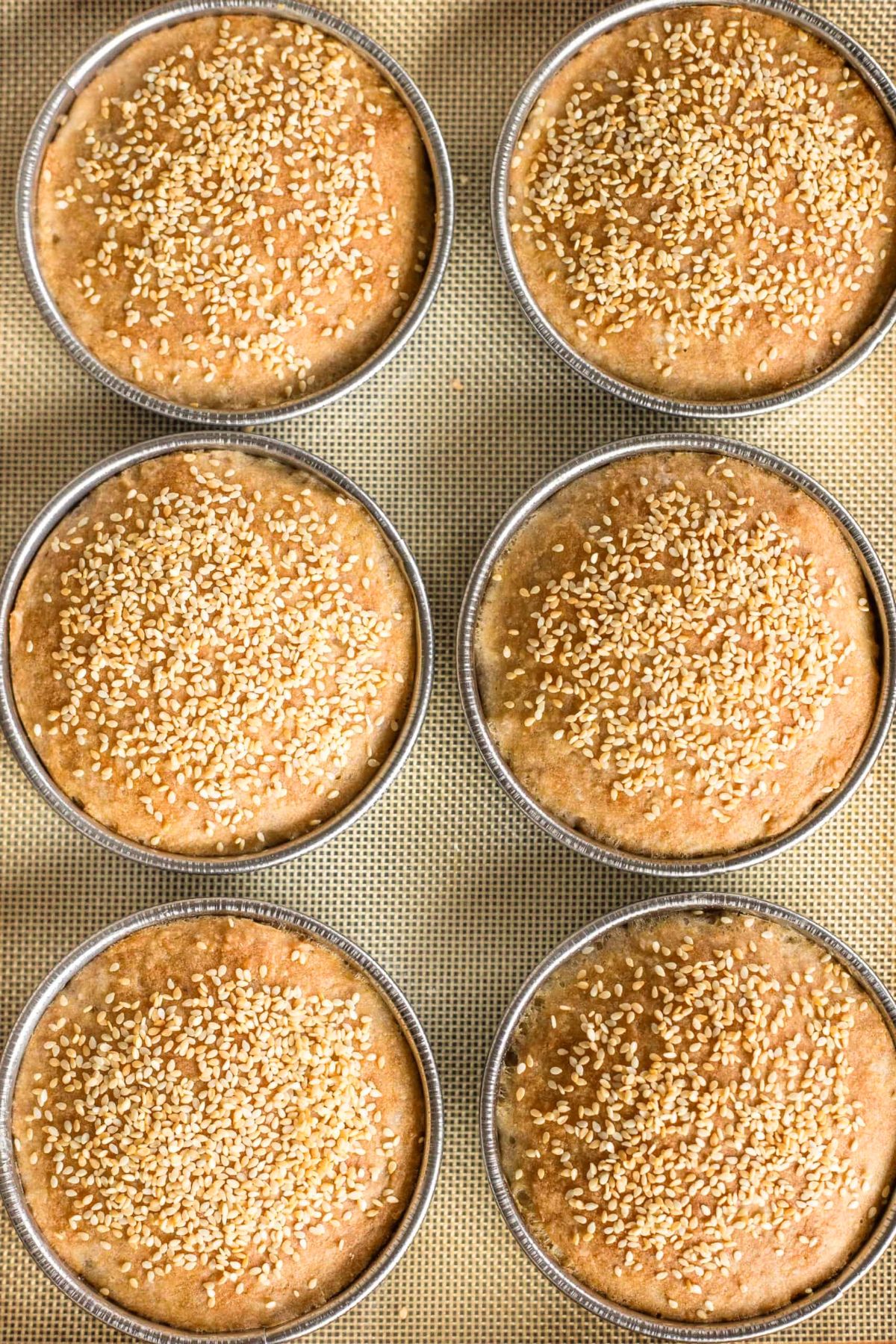
9. Let Cool Before Removing
Once baked, let the gluten-free hamburger buns cool for at least 10 minutes in the metal rings before running a butter knife around the edges of the rings and removing the buns.
Transfer the buns to a wire rack to cool completely at room temperature.
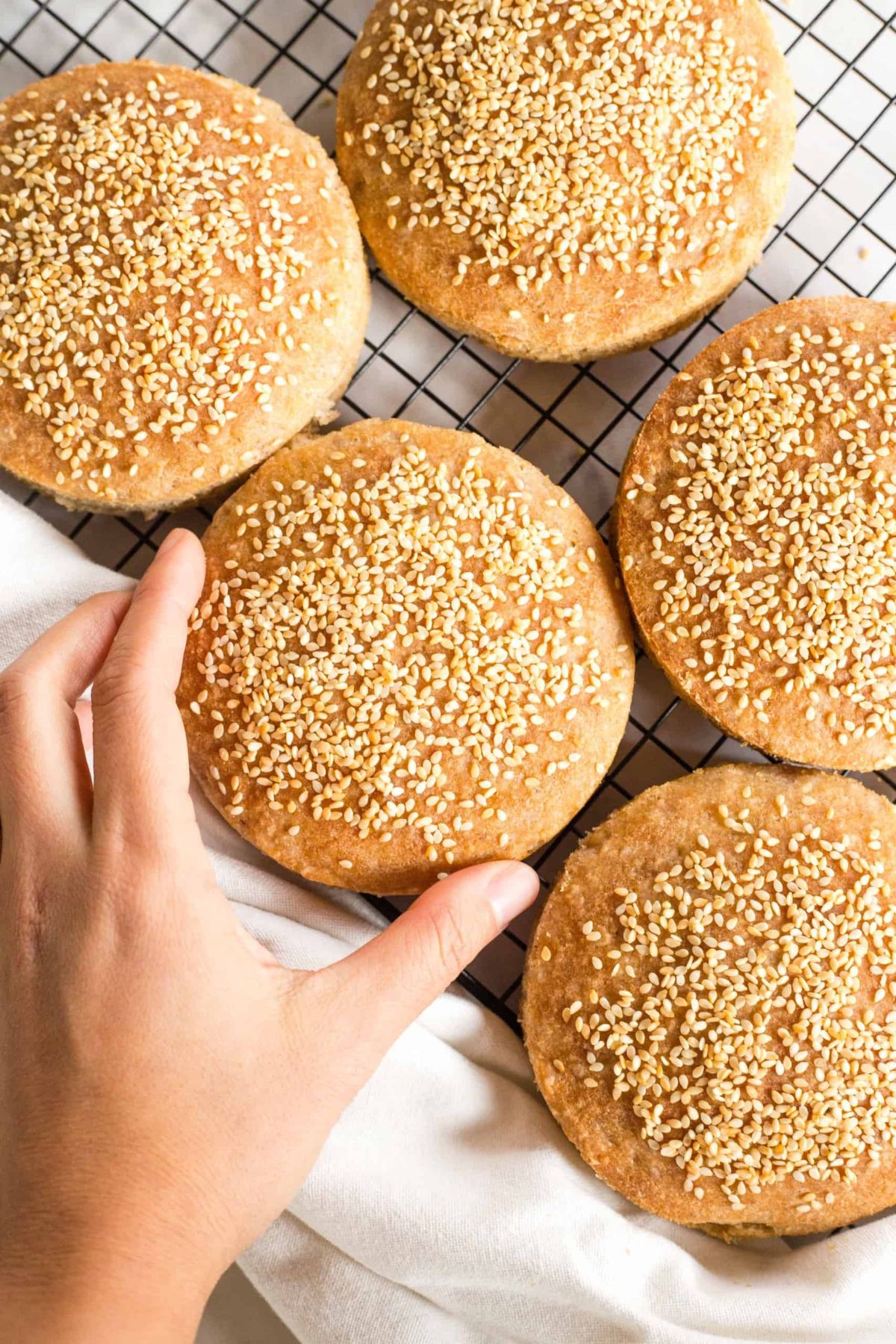
Dish by Dish Tips/Tricks:
- Grease Metal Rings: Make sure you brush the sides of the metal rings with oil or spray them with nonstick cooking spray to prevent the buns from sticking to the rings (this will make it much easier to remove the hamburger buns once they are baked).
- No Metal Rings? Use Muffin Mold: If you don’t use metal rings, you may also use a muffin pan instead (this will yield smaller buns that are perfect for mini sliders).
- Toast Before Eating: If you like, you can also toast these hamburger buns on the grill before eating them.
- Make Hot Dog Buns: You may also use this dough with a hot dog bun mold instead so you can also enjoy gluten-free hot dogs!
Recipe FAQs:
To store, place the cooled gluten-free hamburger rolls in an airtight container and keep in the refrigerator for up to 3 days.
To freeze, wrap the gf burger buns in various layers of plastic wrap and freeze for up to 2 months. Let the frozen buns thaw completely overnight in the refrigerator before slicing or using these fluffy buns.
Traditionally, hamburger buns are made with wheat flour (which contains gluten). As such, most store-bought burger buns or buns sold at restaurants are usually not safe for Celiacs or those with gluten intolerance, unless the buns are specifically stated to be gluten-free.
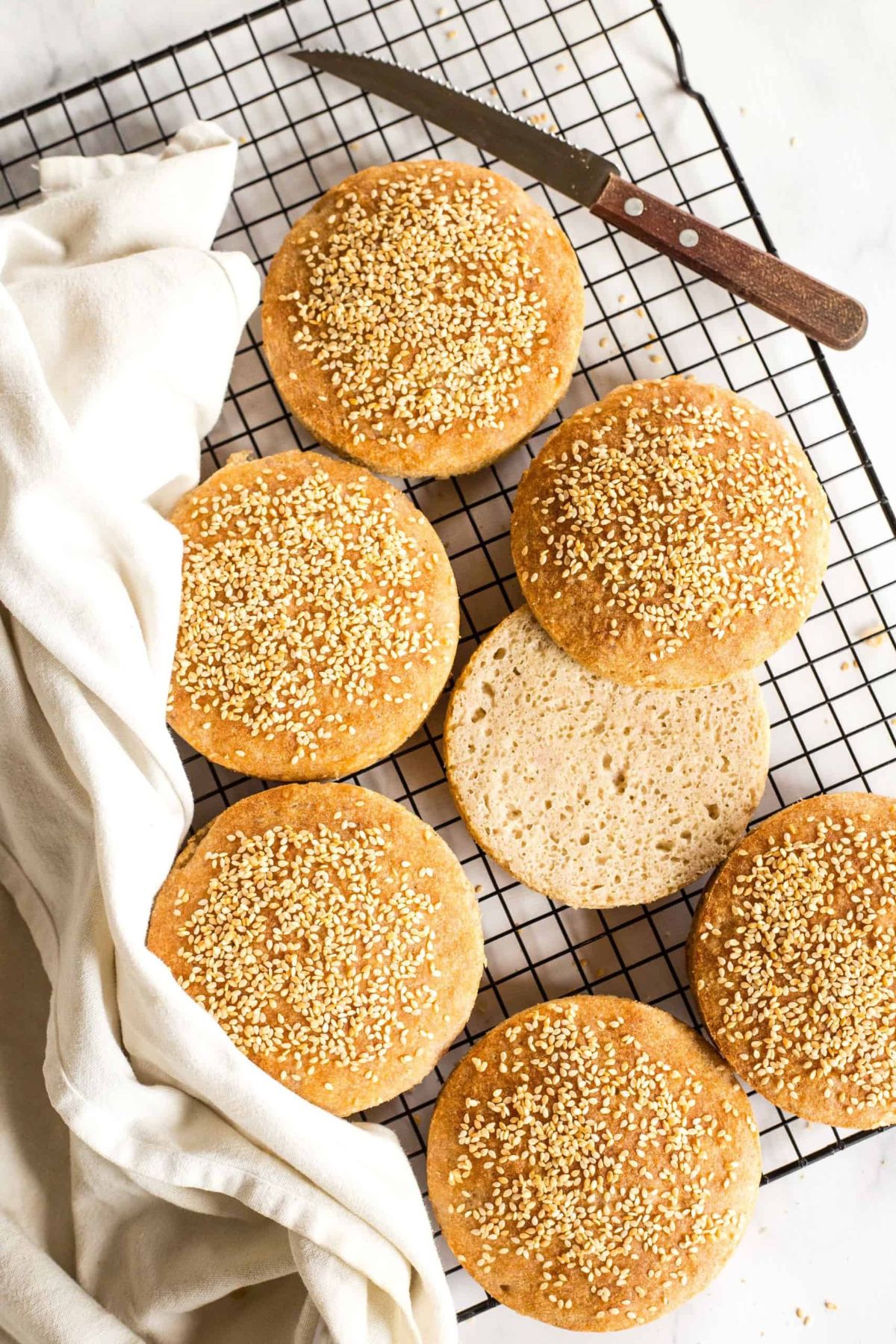
Other Gluten-Free Yeast Breads You’ll Love:
- Gluten-Free White Bread (Dairy-Free)
- Easy Slider Buns (Gluten-Free, Dairy-Free)
- No-Knead Artisan Bread (Gluten-Free, Dairy-Free)
- Bagels (Gluten-Free, Dairy-Free)
- Fluffy Potato Bread (Gluten-Free, Dairy-Free)
- Buckwheat Bread (Gluten-Free, Dairy-Free)
- Brown Rice Bread (Gluten-Free, Dairy-Free)
- Teff Bread (Gluten-Free, Dairy-Free)
- Potato Bread (Gluten-Free, Dairy-Free)
- Sorghum Bread (Gluten-Free, Dairy-Free)
- Quinoa Bread (Gluten-Free, Dairy-Free)
- Hot Cross Buns (Gluten-Free, Dairy-Free)
- 21 Fluffy Gluten-Free Yeast Bread Recipes
P.S. If you try this recipe, I’d love for you to leave a star rating below, and/or a review in the comment section further down the page. I always appreciate your feedback. Be sure to check out my entire Recipe Index for all the recipes on the blog. You can also follow me on Pinterest, Facebook or Instagram! Sign up for my Email List to get fresh recipes in your inbox each week!
Print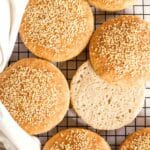
Gluten-Free Hamburger Buns (Dairy-Free)
- Total Time: 1 hour 25 minutes
- Yield: 6 buns 1x
- Diet: Gluten Free
Description
These soft and fluffy gluten-free burger buns are perfect for your summer backyard grilling party (or anytime you crave a good burger). Easy to make, these tender gf hamburger buns are studded with sesame seeds, and no kneading is required! Totally dairy-free too, but no one would care!
Ingredients
- 2 1/4 cups gluten-free all-purpose flour
- 3/4 teaspoon xanthan gum (omit if your gluten-free flour blend already has it)
- 1 teaspoon baking powder
- 1 teaspoon salt
- 2 1/4 teaspoons instant yeast
- 1 tablespoons sugar
- 2 tablespoons psyllium husk powder
- 1/3 cup sunflower oil + more for brushing
- 1 teaspoon white vinegar (or apple cider vinegar)
- 1 1/2 cups warm water
- 2 large eggs, beaten, room temperature
- 2 tablespoons white sesame seeds
Instructions
- Preheat, Line and Grease: Preheat oven to 350F and line a large baking sheet with parchment paper or a silpat. Grease 6 round metal rings and place on the mat.
- Whisk Dry Ingredients: In a large mixing bowl, whisk the gluten-free all-purpose flour, xanthan gum (if using), baking powder, salt, instant yeast, sugar and psyllium husk powder.
- Add Wet Ingredients: Add the vegetable oil, vinegar, warm water and beaten eggs. Mix well until you get a dough that resembles cake batter (the dough will be shaggy and wet, but that’s the consistency you want).
- Divide Dough Between Rings: Divide the dough evenly between the metal rings and smooth out the tops of the dough with the back of a wet spoon.
- Let Rise Until Doubled: Allow the dough rise in a warm, draft-free place until it has roughly doubled in size. (Depending on the temperature and humidity, it may take as little as 30 minutes in a warm and humid climate or up to 1 hour in the winter).
- Brush with Oil: Use a silicon brush to brush the tops of the dough with oil.
- Sprinkle Seeds on Top: Sprinkle sesame seeds on top of the dough.
- Bake: Bake the buns for 30 to 40 minutes until golden brown on top.
- Let Cool Before Removing: Once baked, let the gluten-free burger buns cool for at least 10 minutes in the rings before removing them to cool completely at room temperature on a wire rack.
Notes
Gluten-Free Flour Blend: I highly recommend using a good-quality gluten-free all-purpose flour blend that is made up of lighter flours/starches (such as rice flour, tapioca starch, corn starch, or potato starch) to ensure a lighter final texture. I do NOT recommend flour blends that include heavier flours (such as garbanzo bean flour).
Xanthan Gum: Xanthan gum is the replacement for gluten in gluten-free flours and helps the ingredients to bind together. If your gluten-free flour blend does not already include xanthan gum, make sure to include it.
Instant Yeast: Yeast is the main leavening agent in this gluten-free hamburger bun recipe, so make sure you include it. I prefer using instant yeast because there’s no need for pre-activation (if you only have active dry yeast, make sure to activate the yeast before hand by mixing it with warm water and sugar and letting it sit for a few minutes before mixing it with the other ingredients).
Sugar: The sugar is “food” for the yeast to feed on in order to be activated and to produce the gases required to make the dough rise. I used white sugar, but you can also use light brown sugar or dark brown sugar if you prefer.
Baking Powder: While this recipe mainly uses instant yeast as a leavening agent, a little bit of baking powder gives the dough a little extra rise. If you are Celiac or gluten-intolerant, make sure to use a certified gluten-free baking powder.
Psyllium Husk Powder: I find that psyllium husk powder really gives gluten-free dough elasticity and makes a big difference in how the final texture of the baked bread turns out. It is also a good source of fiber. If you only have whole psyllium husks available, you can grind the husks in a coffee grinder until you get a fine powder.
Oil: I like using sunflower oil because I always have a bottle of sunflower oil on hand. However, you may also use other vegetable oils such as extra virgin olive oil, avocado oil, or melted coconut oil. Alternatively, if you are not lactose-intolerant, feel free to use melted butter or ghee instead.
Vinegar: Adding vinegar creates an acidic environment that reacts with the baking powder to help the dough rise more. You can either use white vinegar or apple cider vinegar.
Warm Water: Make sure that the water is between 105 to 115F (neither too cold nor too hot), as you need a little warmth to activate the yeast, but if the water is too hot, it will cause the yeast to die. Alternatively, you may also use warm dairy-free milk (such as almond milk, cashew milk, or rice milk) or normal milk instead.
Eggs: Eggs help the ingredients to bind better together. I have not tried this recipe without eggs so I don’t know how it will turn out, but if you are allergic to eggs, you may try using aquafaba or an egg-replacer. (If you do make this recipe egg-free, please let me know how it goes in the comments below, I’d love to hear!)
Sesame Seeds: I like sprinkling white sesame seeds on top of the buns, but you may also use a mix of sesame seeds, or other seeds of your choice. For extra flavor, you can also sprinkle everything bagel seasoning on top of the dough. Alternatively, feel free to leave out the seeds directly if you prefer.
Storing/Freezing: To store, place the cooled gluten-free hamburger buns in an airtight container and keep in the refrigerator for up to 3 days. To freeze, wrap the buns in various layers of plastic wrap and freeze for up to 2 months. Let the frozen buns thaw completely overnight in the refrigerator before slicing or using.
- Prep Time: 15 mins
- Rising Time: 30 mins
- Cook Time: 40 mins
- Category: Bread
- Method: Baking
- Cuisine: American

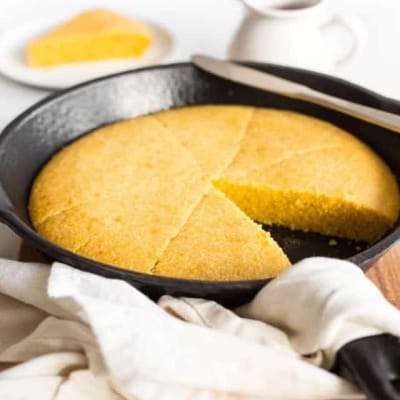
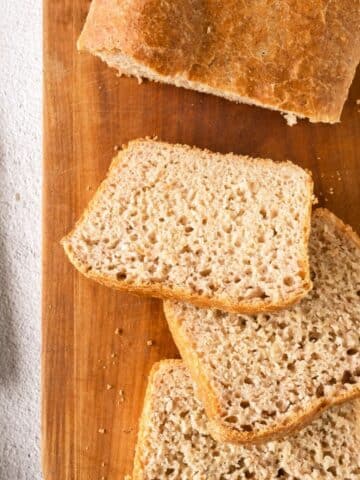
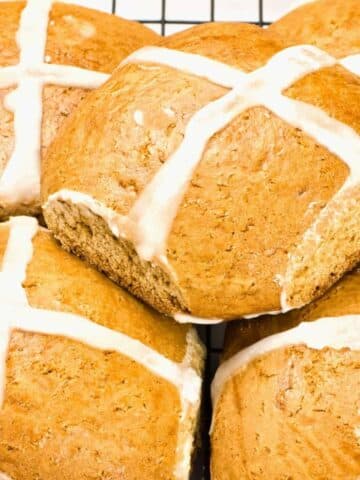
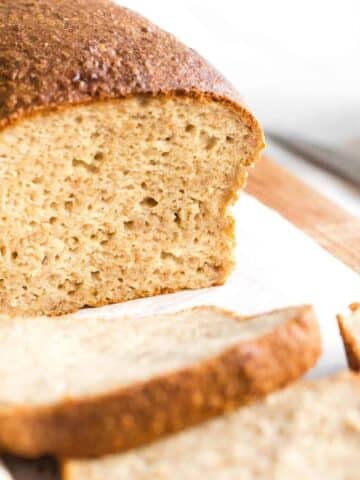
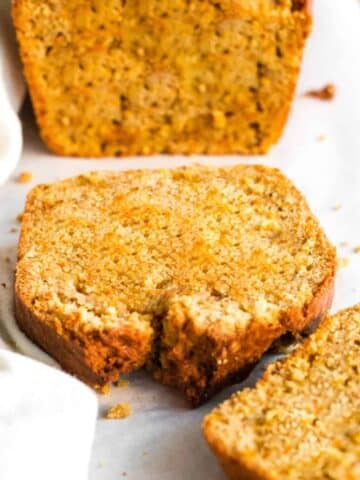
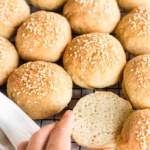
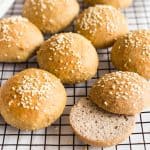
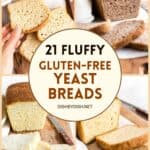
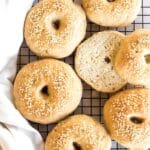

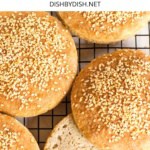

My family loved these hamburger buns. I used Bob’s Red Mill egg replacer and 1 to1 gf flour. They freeze well and toast up crispy. I don’t have rings so I used 5 inch round pans. Will be making these again.
So happy to hear this Marsha! Thanks for sharing your substitutions, and hope to see you around the blog again sometime soon!
xx,
felicia
I love this as buns.can it also be made in a loaf pan? And how would you adjust the baking time?.
Hi Silvia! Yes you can make this recipe in a loaf pan! I would transfer the dough into the greased baking pan then let it rise for 30-40 minutes until almost doubled in size, then bake for 60 minutes at 350F until golden brown on the outside. Let loaf rest at room temp on wire rack for 30 minutes before slicing. If you find that the loaf is still wet inside, bake for another 10 minutes.
OMG! I made these today and your Soft & Fluffy Bread for the 3rd time. These came out FANTASTIC and taste so good. I have 2 four holder silicone hamburger bun forms I used. I can’t use “Psyllium Husk Powder”, because it hurts my stomach like crazy. So I do what I always do. I substituted GLUCOMANNON. Only, one thing happened. My hamburger buns quickly rose to nearly 3 inches tall and after baking they were even taller. They were GINORMOUS. I think the 2 tablespoons of Glucomannon might have done that. So, after they cooled, I cat about 1/2 of them out from the center and we’ll use it for french toast tomorrow. I used Cup 4 Cup flour, used an egg wash and toasted sesame seeds on top. For the oil, I used Butter Flavored Coconut Oil. They were nicely browned on the tops and bottoms and the sides were just lightly brown. It made 8 HUGE buns, but I could have easily made 14 to 16 regular sized buns, if I would have used my silicone molds twice. I did spray my silicone molds, although I know most people say that’s unnecessary. After letting them cool in the pans about 10 minutes, they popped right out. I finished letting them cool on the racks, before I cut the middles out. Then, I wrapped each in foil and froze them. These were so delicious, they could easily be used for dinner rolls, too. But, I’ll be using this recipe for my hamburger and hot dog buns. Next time I make them, I’m going to try adding 1/4 cup fed sour dough starter. Sometimes I like buns with a little bit of a sour dough taste and I think this would work well with it. If I use the sour dough starter, I’ll omit the vinegar. this recipe is a big keeper!!
YAY! So happy to hear that you enjoyed these GF burger buns dear! Thanks for sharing the substitutions you used. I’ve never tried glucomannon before, and it sounds like a good replacement for psyllium husk powder for those who cannot tolerate psyllium. P.s. Love the idea of using this dough to make gf hot dog buns too! Hope to see you around the blog again sometime soon!
xx,
felicia
Simply perfect recipe! I made half of it to test and it worked so well that I regretted not having done all of it. Beautiful and super fluffy breads! Wonderful!!
(I just suggest including the measurements in grams, for the measurement to be more accurate).
Thank you and a hug directly from Rio de Janeiro, Brazil! 🙂
Hi Diana! Obrigada!! YAY! So happy to hear you enjoyed these burger buns! Thank you for your feedback, I appreciate it! And sending you a hug back!
I wish you tried a no egg recipe. I’m just starting out and already had a couple of fails trying out my own egg free alternatives. I can’t really afford waisting ingredients on more fails.
Hi Mel, thanks for the suggestions, I will take that into consideration and perhaps test out egg-free recipes next time.
I so want t o try these out but scared !! i have had 3 fails with GLuten free bread:(
the center is always gooey and not cooked:( What am I doing Wrong?
This blend is a GF self raising FLour from Marks and spencer is it ok to use it for making this bread ?
The blend – Rice Flour + Tapioca Starch +potato Starch + Maize Flour + Raising agents- Calcium phosphate+ sodium bicarbonate +xanthan gum
Your response and guidance would be of great help..
Hi Surabhi, these burger buns are best made with a gluten-free all-purpose flour. Seems like the flour blend you have is a self-raising flour (since it has raising agenets) – and I don’t think that will be best for this recipe. Do you have access to King Arthur Flour gluten-free all-purpose flour?
I was excited to try this recipe! First time using the phylum husk and my buns came our purple and overflowing
over the rings. They were spongy and soft! Was just wondering how much citric acid I and to the mix to prevent the color purple????
Hi Cynthia, glad you liked the texture. Regarding the color, the purple is caused by the psyllium husk you used (some brands don’t make the bread turn purple, other brands do). I know the brand NOW doesn’t make baked goods purple, you can find it on Amazon or in natural food stores, or in some supermarkets. Hope this helps!
Wow, these hamburger buns were so soft and fluffy in texture! So shiok!
I like how you combine instant yeast, baking powder and vinegar together as agents for the bun to rise and create such a great softness in the texture with even air pockets within the buns!
Thanks Felicia for explaining how these various rising agents work together to produce the desired outcome.
Love you lots 🙂
Mum
Hi mummy! So happy you enjoyed these hamburger buns! 🙂